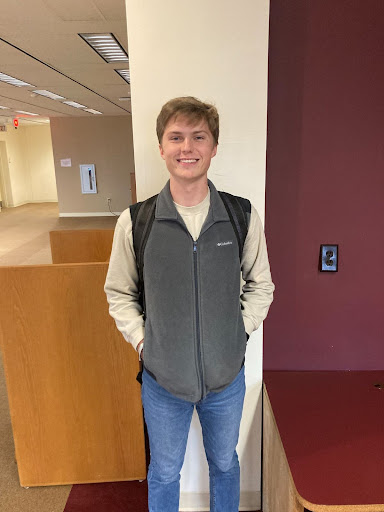Report highlights treatment of faculty

In the fall 2017 semester, 33.9 percent of Guilford courses were taught by contingent faculty, part-time or full-time faculty members who are not tenured or on the tenure track.
This year, the Guilford College chapter of the American Association of University Professors chose to focus on the treatment of contingent faculty members at Guilford. The AAUP conducted a survey of 35 contingent faculty members, which was compiled in a report entitled, “Still Here: Contingent Faculty at Guilford,” by Dana Professor of Psychology and AAUP President Richie Zweigenhaft.
The AAUP has conducted two similar surveys of contingent faculty in the past, one in 2011 and one in 2014.
“This year, choosing to do contingent faculty was simply, in my view, that enough time had gone by since the second report,” said Zweigenhaft. “The other reason it seemed like a good time to check in is, as I wrote in the introduction to the report, that there’s been such tremendous turnover in the leadership of the College.”
Vice President for Academic Affairs and Academic Dean Frank Boyd believes that the content of the report is significant, though not surprising.
“I think it’s noteworthy and remarkable that Guilford College has had a report of this kind done now three times, 2011, 2014 and now 2017,” said Boyd. “The issues that Richie outlines in the report are omnipresent in higher education, and we are all struggling and doing our best to provide support for contingent faculty members, and so none of the content of the report struck me as surprising.”
Some of the issues faced by contingent faculty that Zweigenhaft highlights in his report are low compensation, lack of benefits and access to resources and invisibility on campus.
“We recommend that when full-time tenure-track faculty receive an across the board increase, a corresponding increase be applied to the compensation for contingent faculty,” wrote Zweigenhaft in the report. This is one of nine recommendations made by the report on how to improve current conditions.
During the 2016-17 academic year, part-time contingent faculty were paid $4,000 per course, plus $500 for courses with enrollments over 25 and $500 for courses that end at 10:10 p.m. or later.
“I think that upping the rate to $6,000 a class would be a good start,” said Part-Time Writing Instructor Meredith Luby. “I know that still doesn’t seem like very much, but that would make a huge difference in my life.”
Other contingent faculty members believe that pay should be improved, but is part of a national issue in higher education.
“In terms of payment, in actuality, Guilford doesn’t pay any worse than other schools do, and it actually pays more than many schools do,” said Continuing Part-time Lecturer of Music Parke Puterbaugh, who has taught “History of Rock” at Guilford for 12 years. “But still, compensation for adjunct faculty is something that needs attention across the board in a systematic way in higher education, but I don’t think that Guilford is particularly bad about that,”
According to Boyd, future compensation changes are possible.
“On the compensation side, in terms of salary, I’ve already had conversations with the faculty chairs about adjunct salaries, and I’ve indicated my openness to having conversations with them about how we take all the resources we have available for salaries and having a conversation about, ‘Do we want to distribute more of that fixed allocation of compensation to adjuncts an ongoing fashion?’” said Boyd.
This year, contingent faculty faced another issue of compensation. Many faculty members did not receive their first paychecks until March, despite beginning to teach in January.
However, Boyd assures that this issue has been addressed and will not happen again.
Another issue addressed in Zweigenhaft’s report was lack of benefits. At Guilford, full-time contingent faculty receive benefits such as health insurance and retirement benefits, while part-time contingent faculty do not.
“We recommend that whenever possible the College provide benefits for contingent faculty, especially those who have taught at the College for a long time,” wrote Zweigenhaft in the report.
While part-time contingent faculty don’t receive benefits such as healthcare, they are eligible for faculty development benefits such as attending workshops and coming to reading groups. Full-time contingent faculty are also eligible for Kenan grants, a grant focused on education, and funding in the form of travel and research.
Associate Professor of Political Science and Faculty Development Director Maria Rosales helps faculty improve their interactions with students and stay engaged with each other.
“I think a lot of times contingent faculty don›t realize that things are open to them that are open to them,” said Rosales. “There were a few specific things I thought I could change. One, when I’m announcing different activities, I put in the newsletter, ‘This is open to all faculty.’”
Even with an open invitation, some contingent faculty members don’t feel comfortable attending faculty events.
“I don›t really feel very comfortable going to faculty lunch,” said Luby. “It just feels a little awkward, like I’m not totally part of the community.”
In addition, some contingent faculty members don’t believe that the faculty development benefits make up for the traditional benefits they don’t receive.
“I am very grateful for these and have taken full advantage of them,” said an anonymous contingent faculty member in an email interview with The Guilfordian. “However, they do not make up for lack of health and retirement benefits.”
Zweigenhaft believes that contingent faculty should be provided with not only information about development benefits, but also access to resources, such as office space, computers and phones.
“Institutionally, however, I would say I think we could do better to make sure that all new contingent employees are provided with information and resources,” said Zweigenhaft. “They should of course have office space if they’re expected to meet with students, and they should of course have a computer and a computer account, and most do, but there are some who fall through the cracks on these things.”
In the 2017 “Still Here” report, 91 percent of contingent faculty surveyed reported having an office space, 100 percent reported having a computer account, 38 percent reported not having been given a computer and 26 reported not having been given a phone.
“The other part of the report that is not as resource intensive, that I think we’re going to be moving on very vigorously, is making sure that all of our colleagues have office space, that they have appropriate computers and that they don’t have to ask around and look for those things, that we have kind of a routinized process so that when an adjunct colleague joins us, that we provide those kinds of professional resources that every instructor needs,” said Boyd.
Some contingent faculty members describe their office space in the basement of Bauman Hall as contributing to a sense of isolation.
“I do feel kind of invisible on campus,” said Luby. “I mean our offices, and I don’t know about contingent faculty outside of the writing program, but all of those of us that are contingent here in the writing program, our offices are down here in the basement. I see my coworkers, but I don’t really see anyone else.”
Other contingent faculty members, such as Puterbaugh, report feeling included in their department, but not in Guilford as a whole.
“In general, I feel very much a part of the music department, not so much a part of the broader community,” said Puterbaugh. “I designed this course, I taught it, I built it to one of the most popular courses on campus, and then every semester when the class schedule is published, it doesn’t have my name attached to it, and it says, ‘Staff.’
“That confuses students who are hoping and expecting that I’m teaching it or want to know who to reach out to to add the course, and they can’t do that because there’s this whole party process of getting my name attached to the course. And that’s something I would like to see happen.”
Boyd proposed a solution to this scheduling issue.
“It may in fact be the case that we need to have a specific date where we know that we will have all of the faculty members’ names and just to make sure that the schedule is amended appropriately,” said Boyd.
Some contingent faculty members believe that this change will not be enough to foster inclusiveness on campus.
“The most important thing is raises, benefits and a system that enables and promotes the conversion of part to full-time positions,” said an anonymous contingent faculty member in an email interview with The Guilfordian. “More office supplies and my name on the course schedule are really not effective. We need systemic change.”
Other contingent faculty members also report wanting to be able to convert from a part-time to a full-time position.
“I’ve been doing this for 12 years at Guilford, and I wish there was a path forward to something more lasting,” said Puterbaugh. “At one point there was enough demand for this course, I could have taught three sections of it, but they couldn’t let me do that because at that point, I would be a full-time instructor and they’d actually have to give me a salary and benefits, so they can’t do that.
“I think as a resource with the background that I have, as a published writer and a senior editor at a national magazine, all the things I’ve done, that if they were a little bit resourceful about it, I think I could be a real asset to the (College) beyond the two courses I teach every semester.”
Some contingent faculty members believe that there was more flexibility for contingent employees at Guilford in the past.
“When I came to the (College) 20 years ago, there was more fluidity,” wrote an anonymous contingent faculty member in an email interview with The Guilfordian. “There was a chance for adjuncts to move from part to full-time.”
According to Zweigenhaft, the report was intended to raise awareness about this and other issues faced by contingent faculty.
“I think the report might lead to some policy changes,” said Zweigenhaft. “I think many department chairs, when they read that report or were asked to read the report thought, ‘I don’t want to be one of those departments where no one talks to the part-time person.’”
Lack of communication and evaluation in some departments is another problem mentioned in the report.
In 2017, 39 percent of contingent faculty surveyed reported that they had never received a written evaluation of their work, and 21 percent reported that they had never had a conversation with their department chair about their work at Guilford.
“The first stop is actually to talk with the chairs collectively, and that conversation begins by asking chairs to share the kinds of things that they have done, their ideas about how to provide developmental feedback to adjuncts,” said Boyd. “If we can talk with each other about the best practices that already exist here, it’s a lot easier to diffuse those practices to other programs.”
Both administrators and faculty hope that the treatment of contingent faculty improve in the future.
“One of the things that I said from the very beginning when I arrived at Guilford was that one of our institutional values is one of community,” said Boyd. “That includes everybody, that includes staff, that includes students and that includes all faculty, tenure-track faculty, full-time, visiting faculty and then adjunct faculty, and so the extent to which we have resources available to make them feel like they›re part of the community, we want to do that wherever possible.”








